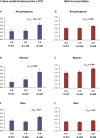PHACTR1 Is a Genetic Susceptibility Locus for Fibromuscular Dysplasia Supporting Its Complex Genetic Pattern of Inheritance
- PMID: 27792790
- PMCID: PMC5085032
- DOI: 10.1371/journal.pgen.1006367
PHACTR1 Is a Genetic Susceptibility Locus for Fibromuscular Dysplasia Supporting Its Complex Genetic Pattern of Inheritance
Abstract
Fibromuscular dysplasia (FMD) is a nonatherosclerotic vascular disease leading to stenosis, dissection and aneurysm affecting mainly the renal and cerebrovascular arteries. FMD is often an underdiagnosed cause of hypertension and stroke, has higher prevalence in females (~80%) but its pathophysiology is unclear. We analyzed ~26K common variants (MAF>0.05) generated by exome-chip arrays in 249 FMD patients and 689 controls. We replicated 13 loci (P<10-4) in 402 cases and 2,537 controls and confirmed an association between FMD and a variant in the phosphatase and actin regulator 1 gene (PHACTR1). Three additional case control cohorts including 512 cases and 669 replicated this result and overall reached the genomic level of significance (OR = 1.39, P = 7.4×10-10, 1,154 cases and 3,895 controls). The top variant, rs9349379, is intronic to PHACTR1, a risk locus for coronary artery disease, migraine, and cervical artery dissection. The analyses of geometrical parameters of carotids from ~2,500 healthy volunteers indicate higher intima media thickness (P = 1.97×10-4) and wall to lumen ratio (P = 0.002) in rs9349379-A carriers, suggesting indices of carotid hypertrophy previously described in carotids of FMD patients. Immunohistochemistry detected PHACTR1 in endothelium and smooth muscle cells of FMD and normal human carotids. The expression of PHACTR1 by genotypes in primary human fibroblasts showed higher expression in rs9349379-A carriers (N = 86, P = 0.003). Phactr1 knockdown in zebrafish resulted in dilated vessels indicating subtle impaired vascular development. We report the first susceptibility locus for FMD and provide evidence for a complex genetic pattern of inheritance and indices of shared pathophysiology between FMD and other cardiovascular and neurovascular diseases.
Conflict of interest statement
The authors have declared that no competing interests exist.
Figures



References
-
- Hendricks NJ, Matsumoto AH, Angle JF, Baheti A, Sabri SS, et al. (2014) Is fibromuscular dysplasia underdiagnosed? A comparison of the prevalence of FMD seen in CORAL trial participants versus a single institution population of renal donor candidates. Vasc Med 19: 363–367. 10.1177/1358863X14544715 - DOI - PubMed
MeSH terms
Substances
Grants and funding
LinkOut - more resources
Full Text Sources
Other Literature Sources
Medical
Molecular Biology Databases

